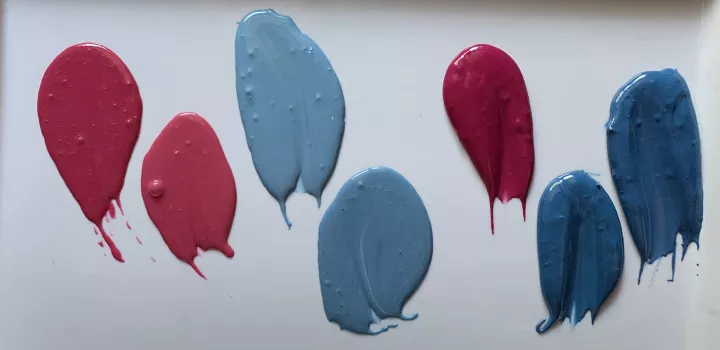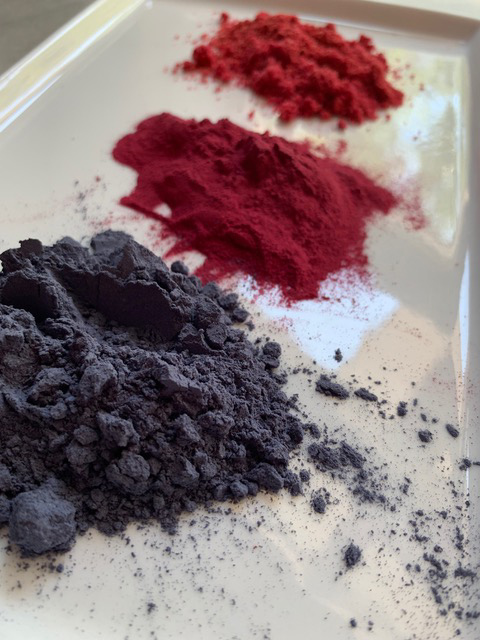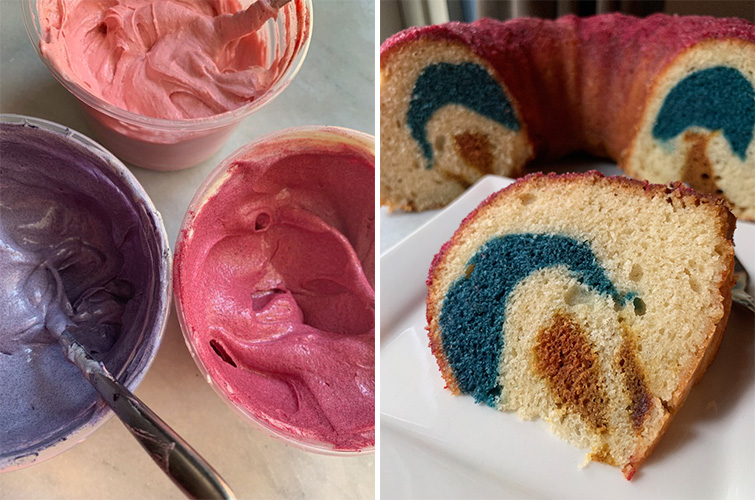
Natural Ways to Color Food Red and Blue
Chef-Instructor Penny Stankiewicz experiments to achieve all-American colors without sacrificing taste, smell or texture.
My neighborhood in Brooklyn is deeply Italian American. In honor of some festival years before, someone painted the fire hydrant and light pole on my block with the colors of the Italian flag. The paint had definitely seen better days and my husband decided to spruce it up. He bought a basic green paint at the hardware store and proceeded to paint the pole white, red and green. He thought that everyone would be super happy that he had bothered to freshen up our little part of the block but instead was hurt when our neighbor, a lifelong resident here, gave some unexpected feedback … “It’s not just any green,” he said. His strong Italian pride was not going to stand by and let an outsider disrespect his country with the flippant use of the wrong shade of green.
Here we are at the week of the Fourth of July, and it’s our national colors that we see used all over to decorate beautiful, festive desserts. As we become more and more aware of the choices we make of what to put in our bodies, we’re looking for more natural options for coloring our sweets. Traditional food coloring can have a host of ingredients, both neutral and bad, but not really good. Professionally, we use either gel paste colors or powder colors to avoid adding too much water to our recipes and changing the working consistency. I’ve been working with food colors for more than a decade, and thought it was time to explore a bit of natural food coloring.
In honor of the Fourth, I’m focusing on the red and blue of our nation’s color palate. White is in there too, but to work with that color you simply leave many products in their natural, uncolored state. You can add touches of color to neutralize some of the off-white tones that can be present. The lightest touch of blue can whiten a white. The opposite color on the color wheel can subtract a color to balance as well.
“It’s not just any green,” and it’s not just any red and blue. The colors we associate with the American flag are deep primary colors. Red was the easiest in my mind. I knew I’d use beet powder. For testing, I focused on royal icing for decorated cookies because its the most white palate to start from.
 I love using powdered food colors for royal icing because they don’t water the product down or change the consistency, so I first tried using the beet powder as I would a powder color, straight in the royal icing. At first, as suspected, it was a light color pink and I had to add and keep adding the beet powder to get to a true American red. It worked. A few things came up: first, the smell and taste of beets. It’s there. The more powder you add to get the right red, the more beet flavor you’re adding. It’s not off-putting, but the earthy smell is definitely there. And as fine as the powder is, it’s also ground up solids, and when adding enough to get to true red, there are small solid pieces in the icing. Had I stopped at pink, it wouldn’t have been so obvious.
I love using powdered food colors for royal icing because they don’t water the product down or change the consistency, so I first tried using the beet powder as I would a powder color, straight in the royal icing. At first, as suspected, it was a light color pink and I had to add and keep adding the beet powder to get to a true American red. It worked. A few things came up: first, the smell and taste of beets. It’s there. The more powder you add to get the right red, the more beet flavor you’re adding. It’s not off-putting, but the earthy smell is definitely there. And as fine as the powder is, it’s also ground up solids, and when adding enough to get to true red, there are small solid pieces in the icing. Had I stopped at pink, it wouldn’t have been so obvious.
On the next test, I tried to first hydrate the powder. All this did was reconstitute the beets and I was left with a textured beet purée. The purée became too liquid to add to the royal icing without watering it down.
For the blue, I’ve learned of the option of cooking down red cabbage in water, adding baking soda to turn it blue and reducing it down. I chose not to try this method, since the cooking down and down to get to a consistency that wouldn’t water down the icing would also change the color, making it duller. Instead, I chose to work with butterfly pea powder from an edible flower. It makes a gorgeous blue. Unlike the beet powder, this powder melts easily into icing. The first additions make a lovely light blue, a color I would strive to make with standard food colors. But to get to that all-American blue, I had to add a lot of powder. To get there, I ended up adding about one-third of a 4-ounce packet to about 1 cup of royal icing. That packet cost $18. An 8-ounce bottle of blue food color costs about $5.
To cover all the bases, I also purchased two brands of natural colors, one gel type and one powder, to compare the results. While both of these made outrageously beautiful colors, I couldn’t get anywhere near the red and blue I was looking for. I added the entire bottle of the gel type, each red and blue into about 1/2 cup of royal icing and the colors were pink and periwinkle. Knowing that lecithin can deepen food colors, I tried to add a bit to each of the colors, and while the depth did change a bit, the colors were not significantly different.
For the natural powder type, I emptied the entire pouch of red into the same amount of royal, and got the most beautiful raspberry but not red. The entire pouch of blue yielded gorgeous periwinkle but not USA blue. I added a touch of baking soda, which can change the color made from blackberries to a deeper blue, but again, no significant changes. At a point, raw baking soda is going to change the flavor, too. The three mini bottles of the gel were about $11 and the four small packets of the powder cost about the same amount.

I used my two favorites in a cake batter to bake my favorite bundt cake. I colored a bit of the batter with the butterfly pea powder and the beet powder. The blue came out deep and beautiful, and the red looked good on the first day, but by the next morning, it had turned an unappealing brownish maroon. I added them to buttercream, too. Pink and purple-ish blue were the results.
All in all, the beet powder and the butterfly pea powder worked the best to get the specific colors I was looking for. The natural food colors really are gorgeous and earthy, but you must embrace them for what they are and not try to bend them to your will. If you can plan your project around their natural beauty and you can absorb the additional costs, then they are a great choice. But as of now, I’m not going to be able to get rid of my traditional food colors. It’s not just any green.
Pursue sweet experimentation with Chef Penny in Pastry & Baking Arts.


Add new comment